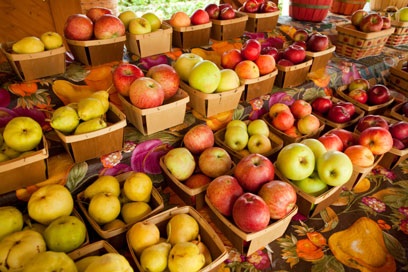 Piles of orange and yellow carrots still wearing their sprawling green tops, fragrant bouquets of basil, cilantro and sage, oddly shaped heirloom tomatoes glowing with a deep red luster ... I'm at the new Phinney Ridge Farmers Market amid tables piled with everything from salad greens to salmon. It's one of many such gatherings of local growers that set up shop for a few hours a week in neighborhoods throughout the Northwest. Add in the twangs of folk musicians, cheery neighbors and a few food stalls (wood-fired pizza, anyone?) to the verdant hues of Northwest fruits and vegetables, and I start wondering, "Is this an errand — or is it a party?"
Piles of orange and yellow carrots still wearing their sprawling green tops, fragrant bouquets of basil, cilantro and sage, oddly shaped heirloom tomatoes glowing with a deep red luster ... I'm at the new Phinney Ridge Farmers Market amid tables piled with everything from salad greens to salmon. It's one of many such gatherings of local growers that set up shop for a few hours a week in neighborhoods throughout the Northwest. Add in the twangs of folk musicians, cheery neighbors and a few food stalls (wood-fired pizza, anyone?) to the verdant hues of Northwest fruits and vegetables, and I start wondering, "Is this an errand — or is it a party?"
What's that?
Not only is a Saturday morning or weekday afternoon visit to the market a sensory delight, it also provides easy access to a greater variety of foods that are fresher, more nutritious and less toxic for your family and the environment than what you can get at your average grocery chain. And one crisp crunch will convince you that food straight from farmer tastes better, too.
Ever tried a Jerusalem artichoke? How about a golden beet? Unlike the large-scale farms that supply most of our grocery stores, many small regional farms grow unusual and heritage varieties of everything from apples to zucchini that you can't find anywhere else. But don't let the kids turn up their noses at an unfamiliar name or a homely countenance — these foods not only have great flavors and textures, they are often more nutritious than their supermarket counterparts that are bred primarily for looks and shelf-life, picked early, then shipped across the globe.
The organic difference
Most of the small, local farms represented at these markets (see below for a list of markets) follow organic and sustainable farming practices, which further ensures a more nutritious bite. Foods are grown in carefully tended soil, which imparts more vitamins and minerals than chemically driven industrial farming practices. Fruits and vegetables are free from toxic pesticides and fertilizers, and from controversial genetic engineering and irradiation. Chickens, pigs and cows are allowed to roam in the sunshine and eat organic grains or grass, without growth hormones or antibiotics. Beyond the requirements of organic certification, the sustainable farming practices employed by many local farmers ensure that valuable Northwest soil and water resources are protected rather than depleted or polluted. All of that translates into fewer toxic chemicals and more vitamins, minerals and high-quality calories on our children's plates, as well as fewer pollutants in the air they breathe, the water they drink and the soil they play in. (For all the facts on going organic, check out our reading list below.)
Voting with your fork
Does something as simple as where you buy a bunch of spinach really matter? You bet. Besides building a healthier, tastier salad, buying locally at the farmers market can be a major political statement and a vote for your values. Looking to reduce green house gases and carbon output? Buy locally grown produce that hasn't been flown, shipped and trucked across the planet and back again. Better yet, carpool, walk or ride bikes to the market, too. Want to keep our waters drinkable, swimmable and fish-friendly? Buy sustainably farmed meat and wild-caught fish. Believe in ensuring a domestic food supply for the future? Support our regional, small-scale farmers. Dismayed that you don't even know your neighbors? Participate in one of these few remaining public commons.
While buying local produce might seem like a small gesture, farmers market shoppers are part of a food movement that is starting to have an impact, and every shopper matters in such a direct producer-to-consumer system. But even with their recent successes, markets, and the family farmers who depend on them, are an endangered species. Chris Curtis, director of the Neighborhood Farmers Market Alliance, says that although the organization has grown, the group is losing spaces to hold these open-air markets as fast as they are gaining ground. Due to rapidly increasing high-density development, the organization has had to search hard for appropriate venues and none of their spaces are secure from year to year.
The dollar factor
In addition to space constraints, Curtis says that another major hurdle facing farmers markets is the popular misconception that the food for sale is prohibitively expensive. Although high-end artisan cheeses and rare and costly mushrooms can be found at many markets, a recent study by students at Seattle University found that in a head-to-head comparison, farmers markets came out as a slightly better deal for staples such as apples, salad and potatoes. The study compared the Broadway Farmers Market, Madison Market and QFC, and the group has plans to expand their work this summer. (Read The Seattle Times article about the study here.)
Many farmers markets accept food stamps (be sure to check in at the main desk to find out how to pay if using food stamps), as well as WIC Farmers Market Nutrition Program Coupons, and many farmers offer great deals such as blemished-but-tasty "seconds" and fruit by the box. Go early for the best choices or visit late for end-of-the-day deals. And you just can't beat eating seasonally for the best savings on Northwest crops.
Go ahead, say "Hello"
One-on-one interactions with farmers at the market also provide a great way to introduce younger kids to how our food is grown and where it comes from, which can encourage healthy, mindful eating, an interest in cooking and excitement about vegetables. (Check out recipes for salads in our online column Taste for what to do with your fresh salad greens and other veggies. Get the kids involved in the whole process!) Plus, by integrating market shopping as a weekly ritual or even by visiting just once, you can show your kids what supporting the community is all about — and how delicious it can be.
Where to go
Check our calendar, and for a comprehensive listing , pick up a copy of the Puget Sound Fresh 2008 Farm Guide at a farmers market or natural foods store near you or visit pugetsoundfresh.org. And don't miss our other resources below.
Breona Gutschmidt has been shopping regularly at farmers markets around Seattle since 1999 and particularly loves Northwest strawberries.
Get the scoop on local farmers markets
Websites
Puget Sound Fresh
Washington State Farmers Market Association
Neighborhood Farmers Market Alliance
Slow Food Seattle *
Localvores.org *
Sustainable Table
Books on eating organic and locally
Animal, Vegetable, Miracle: A Year of Food Life, by Barbara Kingsolver
Fields that Dream: A Journey to the Roots of Our Food, by Seattle author Jenny Kurzweil *
The Omnivore's Dilemma: A Natural History of Four Meals, by Michael Pollan *
The Organic Cook's Bible, by Jeff Cox
Plenty: One Man, One Woman, and a Raucous Year of Eating Locally, by Alisa Smith and J.B. Mackinnon *
* Recommended by Chris Curtis of the Neighborhood Farmers Market Alliance.









